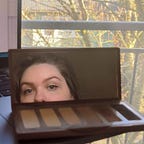Diverse Imagery in Branding
This article was originally written for Awake Ari Magazine, Summer 2019.
You’re scrolling through Instagram, whizzing past image after image of perfectly curated food pics, selfies, and ads. You are bombarded with photos of stunning, sculpted young people posing flawlessly for the camera, taunting you with their seemingly effortless perfection. They’re white. They’re able-bodied. They perform their pre-defined gender roles of man or woman because they’re definitely cis-gendered and probably heterosexual. They’re wearing (and probably selling) high-end fashion, accessories, or tech. Depending on your own identity, you may not even notice that this homogenous show of Pretty Instagram People doesn’t reflect the actual population of the world; not even a little bit.
So why is it that so many media representations conform to the same standard of “normal”? Why is a straight, white, conventionally attractive, fit and able-bodied person the go-to stock photo for every corporation, even when they claim to be #inclusive? And how do we, as thoughtful creatives, avoid participating in the erasure of so many real people that don’t fit this Barbie & Ken mold?
The first step is to find your“why.” (I like to think that this is the first step to anything I do, ever.) For me, “being inclusive” isn’t about checking every diversity box. Between age, race, gender, sexuality, nationality, religious affiliation, economic background, physical and mental ability, and any combination of these, every single person is a collection of identities and intersections. There’s no way we can list and represent every intersection in every piece of media or branding, but that doesn’t mean we can’t try.
True inclusion represents people from all walks of life, from as many intersectional identities as possible. We want to see and hear from black trans women! We want see and hear from hispanic non-binary people! We want to see and hear from Muslim women who use mobility aids! We want to hear from every type of person there is, because every person’s experience is different and important.
Once you have your “why”, make inclusion a priority, not an afterthought. When we design a brand at Casi Ari, inclusion and diversity are inherently part of the brand. Right from the start, we include it in the language, the imagery, and sometimes the mission. Inclusion is more than a priority for us; it’s integral to who we are and what we offer our clients.
I spend hours searching for the perfect stock photos that are on-brand and as diverse as possible. We aren’t perfect — sometimes, with very specific audiences or products, it’s incredibly difficult to find inclusive stock photos that fit the mood and message. It’s even harder to find stock photos that aren’t based on stereotypes (for example, not all Middle Eastern women wear hijabs) or that show people of color in positions of power. Designers and other creatives are starting to push back and demand more from the big stock photo providers, but for now, you can find my little list of go-to sources here.
From there, all there is left to do is the ongoing work of being thoughtfully inclusive. This means doing your research, listening to your audience, and using your platform to lift up as many diverse voices as possible. If your audience tells you they want to see more diversity, listen to them and ask questions. If you’re informed about the way your audience experiences the world, you can anticipate their needs and provide thoughtful solutions. Consider how visually impaired folks may use your website, or how a person who uses a wheelchair might navigate your storefront. Think about how you can provide a product selection that works for people with different financial backgrounds. Ask yourself if any of your brand’s language or imagery may be exclusionary, appropriative, or based on stereotypes rather than facts. Don’t try to mimic or pander to communities that you don’t belong to — just be mindful of their experiences.
We’re all human and we naturally want to see people who look like us and share our experiences. It’s what makes us relate to one another, and I’d argue it’s one of the many things that makes us undeniably human. As attentive creatives, our mission is to make a positive impact on the world and humanity as a whole, and including as many different people from as many different backgrounds as possible is crucial to creating a world where we can all feel seen and heard.
